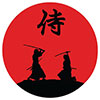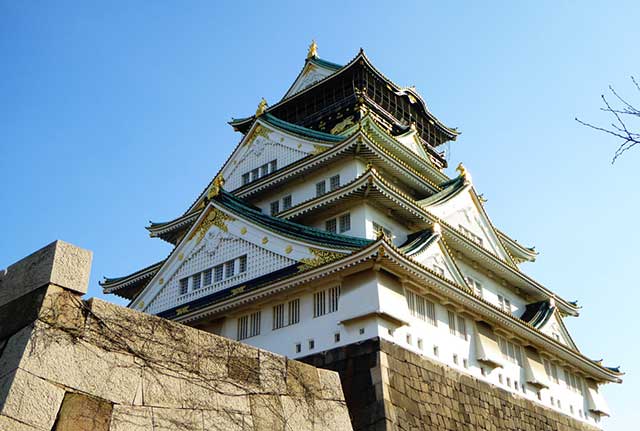
Osaka Castle is a prominent symbol of Osaka City, originally constructed in 1583 by Toyotomi Hideyoshi on the site of the Ishiyama Hongan-ji temple-fortress, which had been the scene of a violent uprising by warrior monks and peasants in the late 16th century. Modeled on Oda Nobunaga’s Azuchi Castle, the original Osaka Castle tenshu (tower keep) featured five visible floors, six interior floors, and two underground basements. The exterior was lacquered black and adorned with gold decorations, including large peony flowers, tigers, birds, and various crests.
The lavish use of gold on Osaka Castle’s exterior surpassed even the grandeur of Azuchi Castle. The shachihoko-gawara (roof decorations with a tiger’s head and a scaly fish’s body), other roofing tiles, and rounded eave edge tiles were all finished in gold leaf. Inside, pillars were lacquered red or black, and walls were beautifully decorated with gold leaf and paintings by leading artists of the time. Hideyoshi often conducted tours of the luxurious keep to enhance his power and authority.
After Hideyoshi’s death in 1598, construction of the castle continued until the entire structure, including the San-no-Maru and all the defensive elements like earthen walls, water moats, and dry moats, was completed. During the Winter Siege of Osaka in 1614, Sanada Yukimura built the Sanada-Maru, a vast defensive structure that greatly strengthened the southern end of Osaka.
Following Hideyoshi’s death, his five-year-old son, Hideyori, inherited the castle. However, the peace achieved by Hideyoshi was disrupted when Tokugawa Ieyasu, the leader of the Council of Regents established to assist Hideyori, made moves to seize power. This led to the nation being divided between the Tokugawa-led East and the Toyotomi-loyal West, culminating in the Battle of Sekigahara in 1600. Although the Tokugawa won, many daimyo remained loyal to the Toyotomi, prompting Ieyasu to launch the Winter Siege of Osaka in 1614. Despite being outnumbered, the Toyotomi forces held off the attack. However, in 1615, Ieyasu raised 150,000 samurai and laid siege to Osaka Castle again, eventually destroying it with artillery and fire, killing thousands of Toyotomi loyalists and ending the Toyotomi clan.
In 1620, the Tokugawa clan rebuilt Osaka Castle to erase any trace of the Toyotomi fortress. The moats were widened and deepened, and the stone walls were reconfigured to reach 30 meters in height. The tenshu was rebuilt about 45 meters west of the original keep, and a three-story watchtower was added. This new castle was partially destroyed in 1660 by an explosion and fire caused by lightning striking a gunpowder warehouse. The main donjon was destroyed by another lightning strike in 1665. Finally, the castle was attacked and burned during the Meiji Restoration in 1868.
The current ferro-concrete tower, reconstructed in 1931, blends old and new elements from different clans and periods. It was based on the shape of the Toyotomi castle but built in the white-walled, green-roofed style preferred by the Tokugawa clan, atop the remaining stone base from the 1620s. Thirteen original Tokugawa period structures remain and are designated as Important Cultural Assets. Notably, the stone walls of Osaka Castle have survived demolition, war, and earthquakes since their construction in the 1620s.
See also
-
Kanazawa Castle
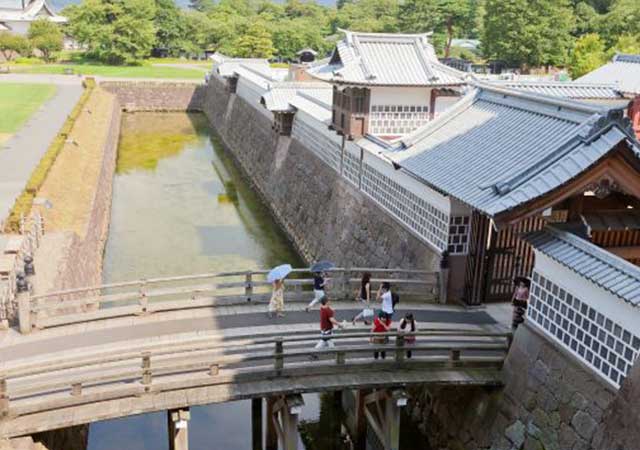
Construction of Kanazawa Castle began in 1580 on the orders of Sakuma Morimasa, a vassal of Oda Nobunaga. The castle was built on the site of the Ikko-ikki sect's Oyama Gobo temple, which is why it is sometimes called Oyama Castle. Morimasa managed to build several moats and begin construction of a castle town. However, after his defeat at the Battle of Shizugatake in 1583, he was executed, and ownership of the castle passed to Maeda Toshiie (1538–1599).
-
Nakatsu Castle
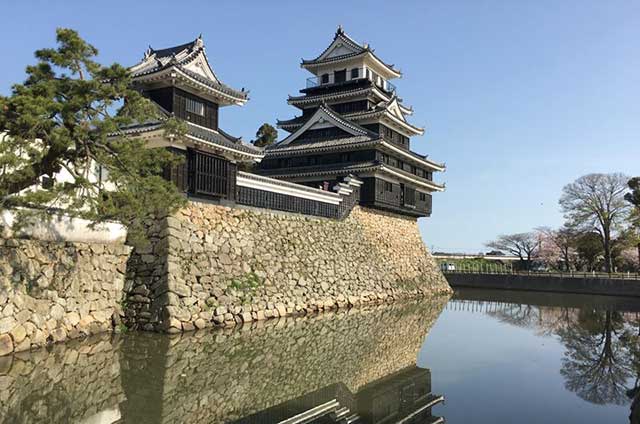
Kuroda Yoshitaka (1546–1604) was one of the closest advisors to the legendary military commander Toyotomi Hideyoshi. He took part in key military campaigns of the late 16th century, including the campaign against Shikoku in 1585 and the campaign against Kyushu in 1587. Later, during the second campaign in Korea, Yoshitaka served as chief advisor to the commander of the invasion forces, Kobayakawa Hideaki. After Hideyoshi's death, he swore allegiance to Tokugawa Ieyasu, thereby securing his influence and patronage under Japan's new leader.
-
Edo Castle
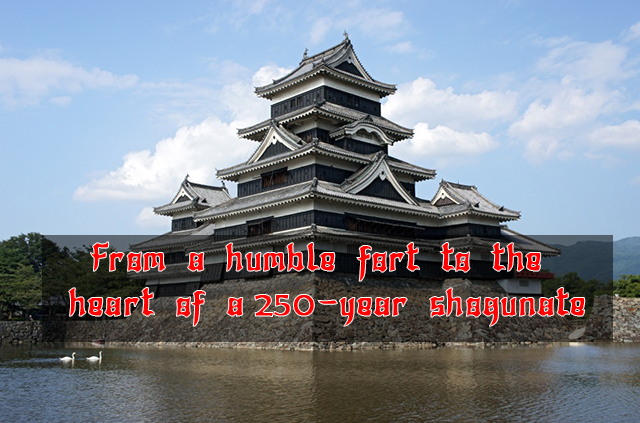
The history of Edo Castle dates back to the Heian period, when the Edo clan built a small fort on this site. In 1457, the vassal of the Uesugi clan, Ota Dokan (1432–1486), constructed a full-scale castle here. Internal conflicts weakened the Uesugi clan, and in 1524, Ota Dokan’s grandson, Ota Yasutaka, surrendered the castle without resistance to the forces of Hojo Soun, the ambitious leader of the Hojo clan. While Odawara Castle remained the clan's main stronghold, Edo was considered a key strategic fortress.
-
Samurai Museum Shinjuku
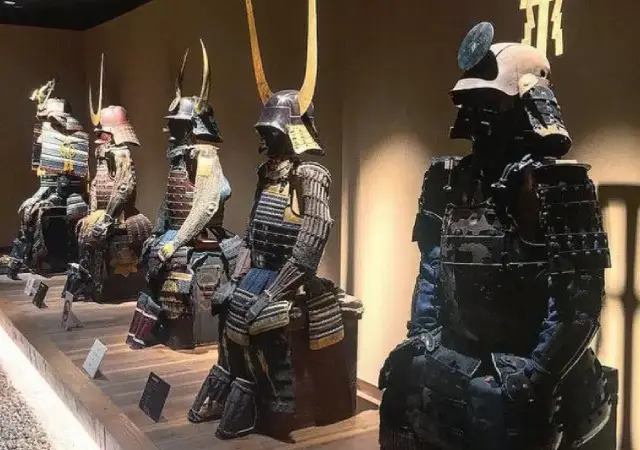
Situated in the vibrant district of Shinjuku, the museum showcases an extensive collection of samurai armor, weapons, and cultural artifacts spanning from the Kamakura to the Edo period. The exhibits aim to convey the samurai's unwavering commitment to honor and discipline, reflecting how their spirit continues to influence modern Japanese culture.
-
Anjo Castle
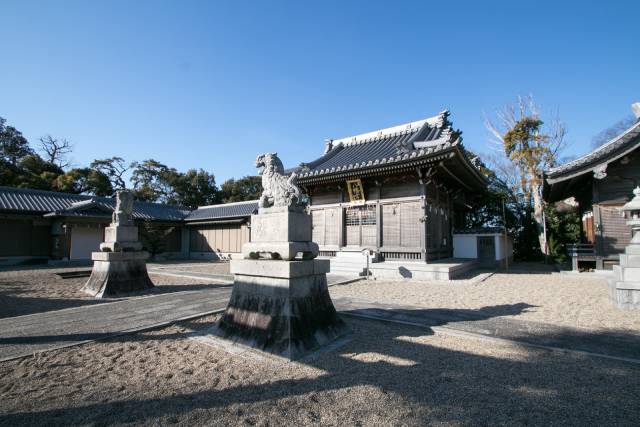
Anjo Castle was built on a slight elevation at the edge of the Hekikai Plateau, about 2 kilometers southeast of present-day central Anjo City in Aichi Prefecture. Today, the surrounding area thrives on large-scale agriculture and automotive manufacturing, utilizing the expansive flatlands and its proximity to the Nagoya region.
-
Numata Castle
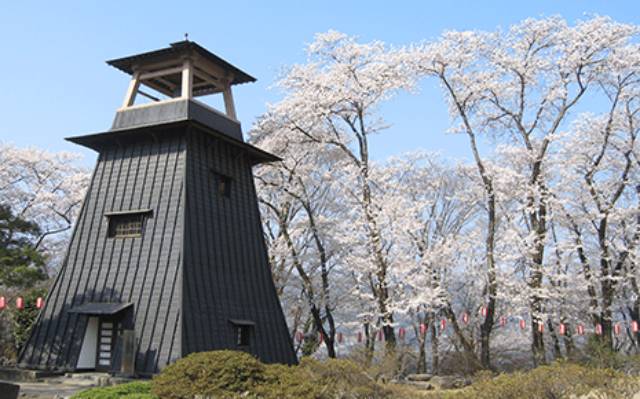
Numata Castle, located in Numata, northern Gunma Prefecture, Japan, has a rich and complex history. During the late Edo period, it served as the residence of the Toki clan, who ruled the Numata Domain. Over the centuries, the castle changed hands multiple times and was the site of significant battles during the Sengoku period.
-
Iwabitsu Castle
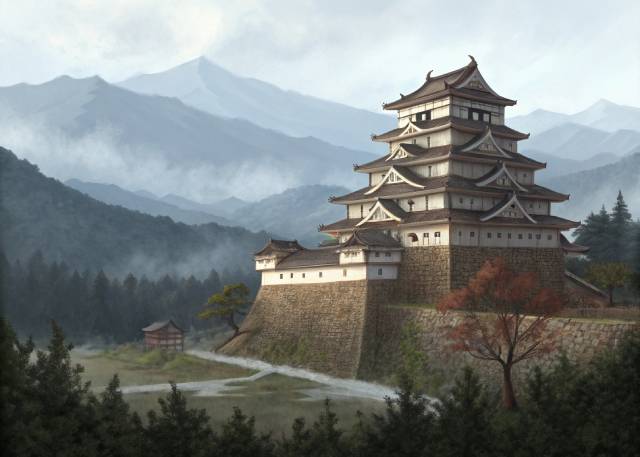
Iwabitsu Castle is a yamashiro-style (mountain) castle located atop Mount Iwabitsu in Higashiagatsuma, Gunma Prefecture, Japan. Recognized for its historical significance, its ruins have been protected as a National Historic Site since 2019.
-
Tsutsujigasaki Castle
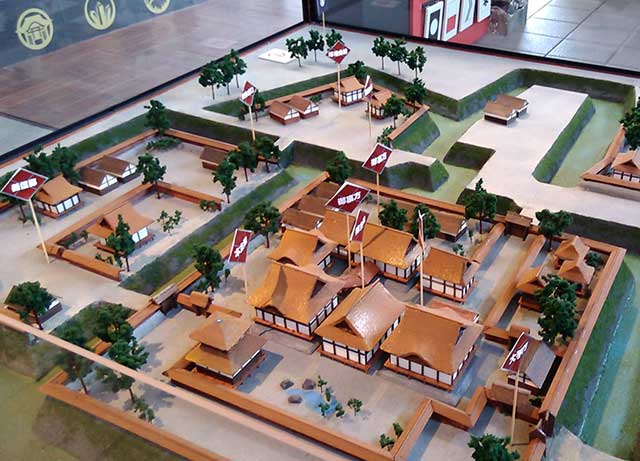
Tsutsujigasaki Castle (Tsutsujigasaki Yakata) served as the fortified residence of the last three generations of the Takeda clan and is located in the heart of Kofu, Yamanashi Prefecture, Japan. Unlike traditional Japanese castles, it was not referred to as a "castle" in Japanese, as the Takeda clan famously believed in relying on their warriors as their true fortifications, stating, "Make men your castle, men your walls, men your moats." Designated a National Historic Site in 1938, the ruins are now open to the public and house the Takeda Shrine, a Shinto shrine dedicated to the deified spirits of the Takeda clan.

